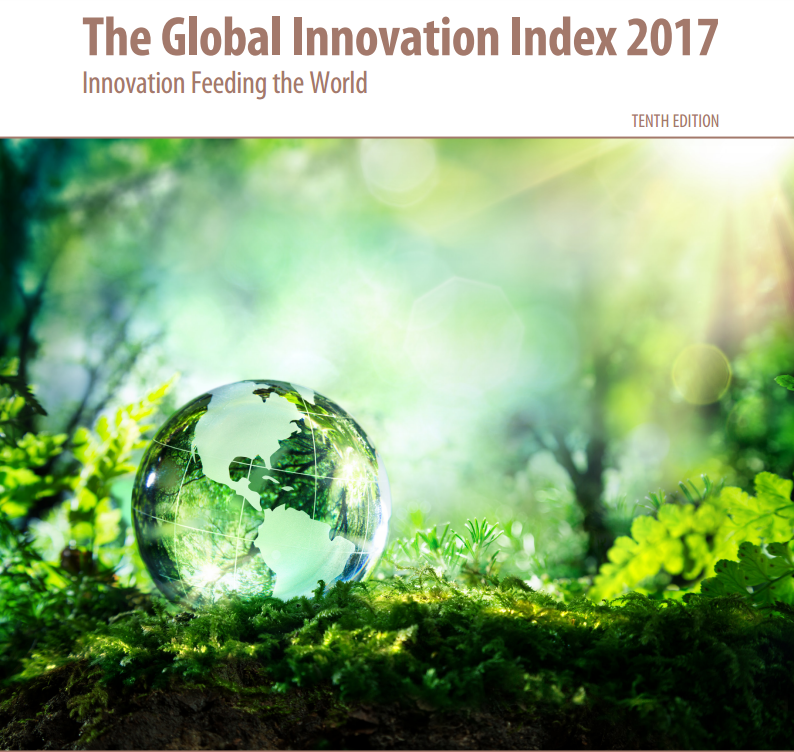
The Global Innovation Index 2017: “Innovation Feeding the World”
Innovation is one of the key factors driving economic growth and development.
This year we are celebrating the 10th anniversary of the well-known Global Innovation Index (GII), which gives a fresh view to the measuring of innovation worldwide.

The GII ranks innovation capabilities and results of world economies. It was first introduced by INSEAD in 2007, and today it is co-published with Cornell University and the WIPO, in collaboration with the 2017 GII Knowledge Partners who, by means of analytics and case studies contribute to the elaboration of GII.
With its 127 economy profiles representing over 97% of global GDP, as well as dozens of other detailed metrics, it has become the leading bench-marking tool. Combining the traditional measures of innovations and new methods, and taking into account multiple indicators, this annually-published index represents a truly broad-based model of innovation. Starting from 2017, GII includes also “invention hotspots” as a special section, focusing on the density of inventors listed in patent applications.
The theme of the GII 2017 is “Innovation Feeding the World”, acknowledging the challenge of combining the rapid growth of world population together with the limited amount of natural resources. As the global demand is on a rapid rise, the optimization of supply and distribution chains, as well as new inventions and creative business models in sustainable food production are called for. Furthermore, as sustainable agriculture and food production require long-term solutions, the effects of climate change in the coming decades cannot be left unnoticed.
Key Findings
According to the GII 2017, the top five most novelty-focused countries in 2017 are Switzerland, Sweden, the Netherlands, the USA and the United Kingdom. High-income economies have traditionally kept the top 25 spots of the ranking, with the exception of China, as the only middle-income nation. Europe, on the other hand, has been dominating the ranking, as 15 of the top 25 best performing economies are European. The key drivers of progress in Europe have been human capital and research, infrastructure as well as business sophistication.
The group of “innovation achievers”, consisting of middle and lower-income economies that are performing better than expected by their current level of development, has been growing. This cluster of 17 countries best represents the innovation incline in the Sub-Saharan Africa region, as nine of the innovation achievers are located there. In addition, Asia has become more and more important with its so-called “innovation tigers”. As Japan, Hong-Kong, Singapore and the Republic of Korea have kept their places as the top innovators of the region, new Asian tigers, including Vietnam, Indonesia, and the Philippines, are emerging and joining the group.
Despite the Asian tigers´ success, it seems that India is the up-and-coming novelty center in Asia. There is great potential that, if India continues its outstanding performance in the following years and collaborates with the new Asian tigers, a whole new engine for worldwide innovation may emerge.
On the other hand, economies in Latin America and the Caribbean have yet to discover their potential as their performance currently remains lower than is expected, in regards to their level of development.
In addition, a lingering large gap in innovative capacity is found to exist between the developed and the developing countries, especially regarding institutions, human capital and research, infrastructure and creative outputs. Furthermore, the amount of R&D activities has remained lower in comparison to previous years.
For more information on innovation worldwide, explore the whole ranking and full report of 2017 here.
Related
- "Neuschwanstein" is not a trademark!
- 1 December 2017: Madrid Monitor takes its place as the one and only tool for tracking international trademarks
- 1 January 2020 - Changes in Classifications - Trademarks, Designs, Patents and Utility Models
- 100th Anniversary of Bavaria (Germany) - A glance at trademarks, start-ups, innovation & events
- 10th Anniversary Edition - 10 Things to Know about LexDellmeier - Past, Present & Future
- 14 June 2013: Munich Patent Law Conference - Calculating Damages in Patent Infringement Cases
- 15 Top Brands - Interactive Brand Rating - Years 2000 - 2018
- 15 Years LexDellmeier - 2024 New Year Wishes
- 2014: Statistics for Community Trademarks
- 2024 World IP Day - Building Our Common Future with Innovation and Creativity
